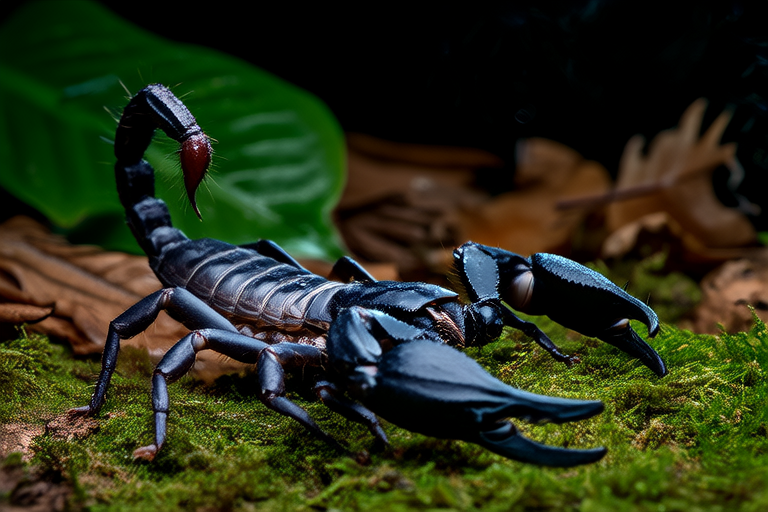Adventures with the Heterometrus Spinifer: A Close Encounter with Nature’s Nighttime Wonders
The world of nature is full of wonders, each creature playing a vital role in maintaining the delicate balance of ecosystems. Among these fascinating beings is the Heterometrus spinifer, a species of scorpion native to Southeast Asia. This article delves into the life of the Heterometrus spinifer, exploring its classification, physical attributes, ecological significance, and the personal experiences of encountering these nighttime wonders.
The Classification and Significance of the Heterometrus Spinifer
Belonging to the class Arachnida and the order Scorpiones, the Heterometrus spinifer is a member of the family Scorpionidae. It is classified under the genus Heterometrus, which includes several species known for their robust size and defensive spines. The name ‘spinifer’ itself translates to ‘spine bearer,’ referring to the prominent spines located on the tail, which serve as a primary defense mechanism against predators.
Within its ecosystem, the Heterometrus spinifer plays a crucial role as both predator and prey. As a top predator in its habitat, it helps control populations of insects and other small arthropods, thus contributing to the health of its environment. Additionally, being prey to larger animals like birds and mammals, it forms part of the food chain, further reinforcing the interconnectedness of all living things.
Physical Characteristics and Unique Features
One of the most striking features of the Heterometrus spinifer is its impressive size, often reaching lengths of up to 20 centimeters. Its body is divided into three main sections: the prosoma, mesosoma, and metasoma. The prosoma houses the eyes, mouthparts, and pedipalps, while the mesosoma contains the legs and book lungs. The metasoma, or tail, is characterized by its formidable stinger, which is equipped with venom glands.
Distinctive among its relatives, the Heterometrus spinifer boasts a series of defensive spines along the sides of its tail. These spines not only serve as a deterrent but also play a role in the scorpion’s courtship rituals. During mating, males use these spines to grasp the female’s pincers, ensuring a secure grip during the transfer of sperm packets. Furthermore, the coloration of the Heterometrus spinifer ranges from dark brown to black, providing excellent camouflage in its nocturnal environment.
Personal Encounters and Safety Precautions
Having spent countless nights exploring the dense jungles of Southeast Asia, I have had the privilege of observing the Heterometrus spinifer in its natural habitat. One memorable encounter occurred during a moonlit evening when I stumbled upon a pair engaged in a mating dance. The male, with his spines delicately intertwined with the female’s pincers, moved gracefully, a mesmerizing sight that highlighted the intricate nature of their reproductive behavior.
Despite their intimidating appearance, interactions with the Heterometrus spinifer can be safe if approached with caution and respect. It is essential to avoid sudden movements and loud noises, as these may provoke defensive reactions. Always wear protective clothing, such as long sleeves and pants, to minimize the risk of contact. Should an encounter occur, it is recommended to back away slowly, giving the scorpion ample space to retreat. Understanding their behavior and respecting their territory are key to ensuring a positive experience.
The Challenges and Rewards of Observation
Observing the Heterometrus spinifer in the wild presents numerous challenges, primarily due to their nocturnal habits and preference for secluded habitats. Venturing into the jungle at night requires careful planning and preparation, including the use of headlamps and thermal imaging cameras to locate these elusive creatures. Patience is paramount, as sightings are infrequent and fleeting.
However, the rewards far outweigh the difficulties. Witnessing the Heterometrus spinifer in action offers a rare glimpse into the hidden world of nocturnal predators. Each encounter teaches valuable lessons about adaptability, resilience, and the importance of preserving these fragile ecosystems. Moreover, the knowledge gained through these experiences contributes to our understanding of these fascinating creatures, fostering greater appreciation for the biodiversity they represent.
Reflections and Lessons Learned
Through my adventures with the Heterometrus spinifer, I have come to realize the profound impact that even the smallest actions can have on the environment. By respecting the habitats of these creatures and minimizing human interference, we can help ensure their survival for future generations. It is a humbling reminder of our place within the natural world and the responsibility we hold in protecting it.
These nighttime encounters have also instilled in me a deep sense of wonder and curiosity about the mysteries of the universe. Each observation brings new insights and questions, fueling a lifelong passion for exploration and discovery. Ultimately, these experiences have shaped my perspective on the interconnectedness of all living things and the importance of conservation efforts.
Encouragement for Appreciation and Conservation
In conclusion, the Heterometrus spinifer is a testament to the incredible diversity of life on our planet. Its unique characteristics and significant role in its ecosystem make it a subject worthy of admiration and study. As we continue to explore and understand the natural world, let us remember the importance of conservation and the need to protect the habitats of these remarkable creatures.
I encourage everyone to take the time to appreciate the biodiversity around them, whether through personal experiences in nature or by supporting organizations dedicated to wildlife preservation. Together, we can ensure that future generations have the opportunity to marvel at the wonders of the Heterometrus spinifer and the countless other species that call our planet home.
